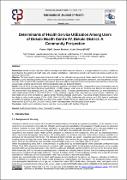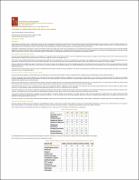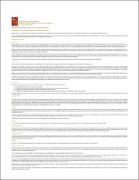Determinants of health service utilization among users of Dokolo Health Centre IV, Dokolo District: a community perspective
| dc.contributor.author | Omona, Kizito | |
| dc.date.accessioned | 2021-03-29T14:18:39Z | |
| dc.date.available | 2021-03-29T14:18:39Z | |
| dc.date.issued | 2021-03-29 | |
| dc.identifier.citation | Ojok, F., Mukasa, S., and Omona, K., 2021. Determinants of Health Service Utilization among users of Dokolo Health Centre IV, Dokolo District: a Community Perspective. International Journal of Health, 8 (1) pp. 17-25 | en_US |
| dc.identifier.uri | http://hdl.handle.net/20.500.12280/2637 | |
| dc.description.abstract | Introduction: Health services utilization (HSU) is an important health outcome indicator, a surrogate measure of access to healthcare that influences the outcomes of health status and consumer satisfaction. Healthcare is central to community well-being as well as a fundamental aspect of life. Objective: The study sought to assess determinants of health service utilization among users of Dokolo Health Centre IV, Dokolo district. Methods: A cross sectional analytical design, which employed both quantitative and qualitative approaches, was used between January and July, 2020. A total of 396 respondents participated. Data was collected using Semi-structured questionnaires and Focus Group Discussion guide. Analysis was done using SPSS and qualitative data was analyzed verbatim. Results: Only 26.8% of the users were satisfied with services provided in the health facility. Living environments of respondents was the only socio-demographic factor that determined HSU (p = 0.046). Living in urban area was 1.6 times more likely to be a determinant of HSU than living in rural setting [COR=1.571, 95% CI (0.986-2.504)]. The study found that being a female was 1.14 times more likely to utilize health services (COR=1.135, 95% CI (0.741-1.739)). Similarly, majority of the respondents who were peasants, 174(43.9%), utilized health services from the facility as opposed to their formally employed counterparts. Thus, being formally employed was 0.7 timesless likely to utilize health services (COR= 0.655, 95% CI (0.29-1.476)). Satisfaction with services (p=0.000), level of satisfaction (p=0.000) and distance to health facility (p=0.033) were enablers of HSU. Being very satisfied was 16 times more likely for one to utilize health services [COR=16, 95% CI (0.000- 0.001)]. Most of the respondents rated the quality of care as poor. Conclusion: Health service utilization remains quite low in many rural health facilities of Uganda. | en_US |
| dc.language.iso | en | en_US |
| dc.publisher | Science Publishing Corporation | en_US |
| dc.relation.ispartofseries | International Journal of Health;8(1) | |
| dc.subject | Health Service Utilization | en_US |
| dc.subject | Community Perspectives | en_US |
| dc.subject | Health Services | en_US |
| dc.subject | Health service users | en_US |
| dc.title | Determinants of health service utilization among users of Dokolo Health Centre IV, Dokolo District: a community perspective | en_US |
| dc.type | Article | en_US |





